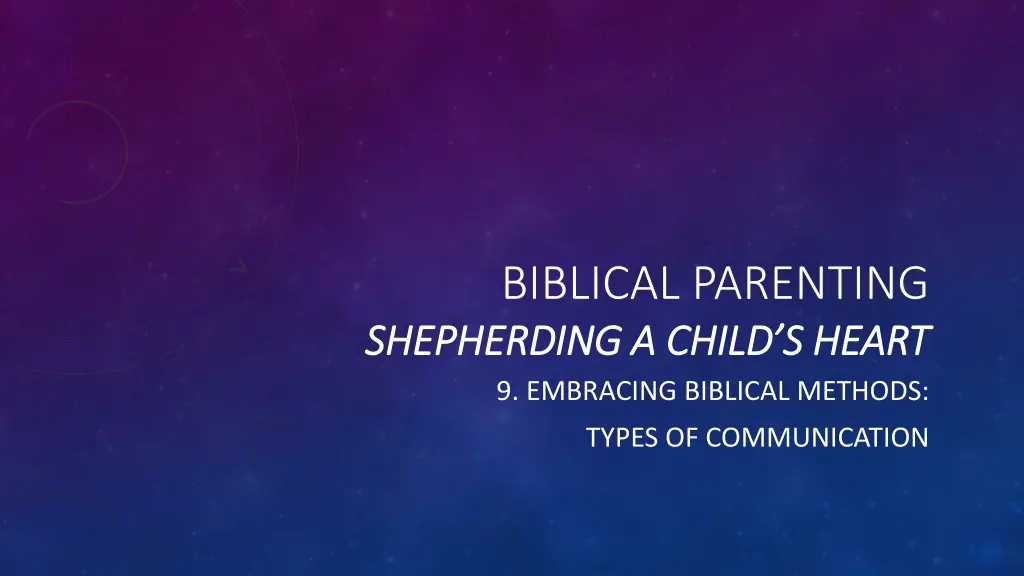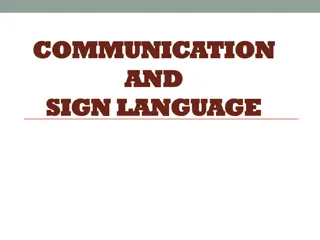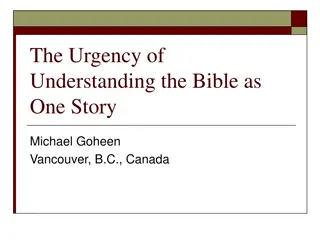
Shepherding a Child's Heart: Embracing Biblical Communication Methods
Discover the importance of biblical communication methods in parenting as you delve into tools like listening, probing, and exposing heart attitudes. Explore how God's Word appoints communication and discipline for raising children.
Download Presentation

Please find below an Image/Link to download the presentation.
The content on the website is provided AS IS for your information and personal use only. It may not be sold, licensed, or shared on other websites without obtaining consent from the author. If you encounter any issues during the download, it is possible that the publisher has removed the file from their server.
You are allowed to download the files provided on this website for personal or commercial use, subject to the condition that they are used lawfully. All files are the property of their respective owners.
The content on the website is provided AS IS for your information and personal use only. It may not be sold, licensed, or shared on other websites without obtaining consent from the author.
E N D
Presentation Transcript
BIBLICAL PARENTING SHEPHERDING A CHILD S HEART SHEPHERDING A CHILD S HEART 9. EMBRACING BIBLICAL METHODS: TYPES OF COMMUNICATION
REVIEW accumulate several tools over the decades. As a professional hoarder, I find it quite difficult to discard any of the tools I may seldom (never) use or even the old models that I have upgraded. And this creates an additional problem for me: where to put all the tools? If I have over 40 screwdrivers, well, the drawer gets pretty full. So if I m attempting a larger project as I did recently, I spend much of my time moving irrelevant tools out of the way, or sifting through the pile of tools to find the right one. (You can expect a huge garage sale sometime in the fall, maybe.) As an amateur carpenter/woodworker/broken-stuff-fixer, I have managed to
REVIEW noted that we may have accumulated a number of unhelpful tools from the world around us: from our own upbringing, from the latest click-bait fad, from the ever - changing discoveries and pronouncements of pop psychology, and so forth. When it comes to raising the children God has entrusted to us for a time, we have
REVIEW What we find from God s Word are two divinely-appointed tools : 1) communication and 2) the rod of corrective discipline. comes to both creation and salvation. No surprises, then, when we find that God has appointed communication, words, as the primary means of raising, elevating the natural born sinners in our midst (or the simple in the language of the Proverbs) into maturity of every variety. And last time (two weeks ago), we opened the subject of communication. We discovered that God has appointed the Word to do all the heavy lifting when it
REVIEW that includes carefully, patiently listening and probing to discover and expose the heart attitude that motivates the child. If you do not or no longer have minor children, the exercise of thinking through our many, often confusing and conflicting desires and goals to locate and expose our own heart attitude would be good practice. Communication, we found, is a two way street, a dialogue more than a monologue, children. But today we want to expand our repertoire of forms of communication with our
INTRODUCTION their tool bag of communication types to only three: Rules, Correction, and Discipline. When it comes to communication in parenting, many parents have severely limited RULES CORRECTION DISCIPLINE And here s how it works: You give the child the rules, correct them when they break the rules, and announce the discipline for their violation. Or one variation of this that I noticed was that I fell into the trap of asking only two kinds of questions: What are you doing wrong? and What bad people are you hanging around with?
INTRODUCTION and discipline. But this limitation is to forget and to forego so much of the rich communication that is available to us and actually commanded of us in the Scriptures. And certainly this must be a part of parental communication: rules and correction So a better paradigm would be something like this:
INTRODUCTION RULES CORRECTION DISCIPLINE Encouragement Correction Rebuke Entreaty Warning Instruction Teaching Prayer
INTRODUCTION essentials, and so much can be missed. Tripp notes that 80-90 percent of parental communication can be spent on the first three categories. Unfortunately in the busy swirl of life, communication can be reduced to the
TYPES OF COMMUNICATION profitable and some of them more enjoyable. A biblical precedent for applying the right form of communication to the right situation comes from 1 Thessalonians 5:14: And we urge you, brothers, admonish the idle, encourage the fainthearted, help the weak, be patient with them all. Notice the changing shape of communication. If someone is idle, the correct word is of admonishment. If a person is fainthearted, the need is for words of encouragement. Many years ago when I had some basic training as a youth worker, and especially in giving counsel, we were encouraged to ask if what the youth needed in a specific situation was a prophet or a priest. If the person was defiant, then they needed a prophet s rebuke. If they were brokenhearted, they needed priestly support and encouragement. Let s look at some of these other forms of communication. They are often more
TYPES OF COMMUNICATION: Encouragement be brutal, a most DIScouraging place. Much of what we hear works to break us down: sin, misery, disappointment, shame, loss. But this seems especially painful in the school years when other kids naturally start picking and teasing (positive proof of the doctrine of original sin!). Children often struggle with their identity, Who am I? especially in comparison with others. Today with all of the enhanced identity questions, this matter calls for greater clarity from the home and pulpit. A. Let s consider ENCOURAGEMENT as an important form of communication. And who can deny the great need for encouragement? This broken, fallen world can
TYPES OF COMMUNICATION: Encouragement someone. Kids may seem to thrive on such flattery, but because it has no real foundation, it will only set them up for unrealistic pride or an eventual collapse. It is manipulation, and manipulation always fails in the end because of its sinful, often unacknowledged ulterior motives. Encouragement is not flattery, empty praise that is intended to artificially inflate
TYPES OF COMMUNICATION: Encouragement but always at bedtime. I would ask this question of my daughter, for instance: If I were to go to all of the houses in all the world, and I were to meet all of the girls in all the world, and if someone were to say that I could have only one girl to be my girl, do you know who I would choose? (I did this with the boys, too, but had to distinguish between big boy and little boy ). Here s a little game I played with all three of our children, sometimes during the day,
TYPES OF COMMUNICATION: Encouragement say, No, she s a fine girl, but not her. She would then name a different girl. And I would reply, No, she s a fine girl, too, but not her. And finally she would say, Me! And I would say, That s right! And do you know why? And the answer she learned to give was, Because Jesus chose me for you, and he never makes mistakes. And my daughter would often tease me back and name another girl. And I would
TYPES OF COMMUNICATION: Encouragement bedtime: an honest compliment, a strong, You can do it! and even a simple, warm, I love you. But all our encouragement must be extended from the Lord. That a father loves his daughter is of great comfort. But that both father and daughter are dearly and eternally loved by Christ is an unshakable foundation of courage and hope. All of that is true, and all of that is very encouraging. Of course, children need encouragement in unplanned moments other than
TYPES OF COMMUNICATION: Correction conformity with a rule. This can be due to negligence or disregard or even willful defiance on their part, but sometimes it may be as simple as forgetting. Children need a lot of reminding. (I find that I need a lot of reminding, too! I keep re- discovering and re-learning truths from God s Word over and over again.) In much of Paul s letters he states that he is reminding his dear ones of important truths. B. Another form of communication is CORRECTION. Sometimes children simply need to be corrected. They need to be brought into
TYPES OF COMMUNICATION: Correction God is correction, according to 2 Timothy 3:16-17: All Scripture is breathed out by God and profitable for teaching, for reproof, for correction, and for training in righteousness, that the man of God may be complete, equipped for every good work. There is no shame in correction, and one of the primary purposes for the Word of
TYPES OF COMMUNICATION: Correction me. often sinfully think I have things too much together to need to be corrected. But the best way to teach your children to love correction is to love correction yourself, and the most important and usual time they will see your reaction to correction is the correction that comes from your spouse, the very person from whom correction can be most difficult to endure. It s sobering to note that the Old Testament prophets link Israel s distaste for correction with the overthrow of their nation. (see Jeremiah 2:30, 5:3, Zephaniah 3:2, 7). Pride, however, resists correction. Pride says, I know, you don t have to keep telling I m fully aware of this situation, because I find myself resisting correction as well. I
TYPES OF COMMUNICATION: Rebuke dismay at what he has done or said. For example, we have always taught our children that there are some necessary limits on free speech. We should never tell people we hate them, or wish death or injury upon them. Such statements would draw a stern rebuke. We would say with evident alarm and indignation, It is wrong for you to speak those words. I never want to hear you speak in such a way again. (This would be followed, of course, by other forms of communication, such as instruction, encouragement, and prayer.) C. A REBUKE goes beyond mere correction in that it censures behavior. Tripp explains: Sometimes a child must experience your sense of alarm, shock, and
TYPES OF COMMUNICATION: Entreaty when the situation is dire or the stakes are very high. We may also think of it as pleading or urging. For example, we find this kind of address at the turning point in Paul s letter to the Romans. After eleven chapters of detailing the glories of God s salvation, including the sobering situation of the lost, Paul then turns to application. And he writes: I appeal to you therefore, brothers, by the mercies of God, to present your bodies as a living sacrifice, holy and acceptable to God, which is your spiritual worship. (Rom. 12:1) He calls for a large response on their part, a response that is fitting to the great subject at hand. And this urgent call is an example of entreaty. D. Another form of communication we find in God s word is ENTREATY. Entreaty is urgent pleading. It is not a common form of address, but is only used
TYPES OF COMMUNICATION: Entreaty begging of a beggar. It is rather the earnest pleading of a father or mother who, understanding his child, the ways of God, and the extremity of the moment, is willing to bare his soul in earnest pleading for his child to act in wisdom and faith. Then he notes: It is a special kind of communication that is reserved for use in cases of great import. (83) It may even take the form of begging, though Tripp notes: It is not, however, the
TYPES OF COMMUNICATION: Entreaty important, every day! But after a couple of weeks of hearing that everything was extremely important, we began to become immune to his pleading. He overused entreaty as a communication device, and it quickly lost its power. We should save it for the big things. We should not say, I appeal to you, Son, as your father who loves you: drink the rest of your milk! I had a teacher in seminary whose subject for the day was always extremely
TYPES OF COMMUNICATION: Warning the warning barricades when the bridge is out. Without them, we will tend to follow our course and suffer loss. Since there are many dangers, toils, and snares in a world gone wild, we must frequently warn our children of the traps and pitfalls, the dangers that they will face. This is what we find in the first several chapters of Proverbs: a father pleading with and solemnly warning his dear son against following the way of fools. E. And a WARNING is intended to put us on guard to potential harm or loss. A warning is just as it sounds, the alert that there is danger in close proximity, like
TYPES OF COMMUNICATION: Warning example, laziness leads to slavery. The person who is lazy will end up in some form of servitude. The warning is an application of the sowing and reaping principle operative in Scripture. Warning your children is not a matter of yelling some pithy saying at them when they are leaving the house to go somewhere. It is acquainting them with the sowing-and-reaping principle found throughout Scripture. It is spending time helping them to understand the many A-leads-to-B statements of Scripture. (85-86) Tripp writes: How do the warnings work? A warning is simply a statement that A leads to B. For
TYPES OF COMMUNICATION: Instruction and Teaching distinction very clear. They are obviously related in that both involve imparting knowledge. Instruction he describes as the process of providing a lesson, a precept, or information that will help your children to understand their world. (84) Teaching he describes as the process of imparting knowledge. (87) F. Tripp distinguishes between INSTRUCTION and TEACHING, but I don t find his
TYPES OF COMMUNICATION: Instruction and Teaching your heart. 7 You shall teach them diligently to your children, and shall talk of them when you sit in your house, and when you walk by the way . Formal teaching is that which is done when you sit in your house, Bible open, instructing children in the ways of God. Informal teaching occurs in more spontaneous ways, when you walk by the way. It might be better to highlight two forms of teaching: formal and informal. Deuteronomy 6:6-7 states: And these words that I command you today shall be on
TYPES OF COMMUNICATION: Instruction and Teaching Blessing Sunday, apparently a special service where people could bring their dogs and cats, hamsters and goldfish to receive a blessing. Okay I went a little ballistic, and when I calmed down, I explained to my children that animals never sinned against the Lord, people did. And so peoplereally need to seek the Lord s blessing through repentance and faith in Christ, not so much animals. It was perhaps a bit strange, but they still talked about it long afterward. Many years ago we were driving in Sioux City and passed a church advertising a Pet
TYPES OF COMMUNICATION: Prayer communication between parents and children with their God. One of the promises parents make when they submit their children for baptism is that they will pray for and withtheir children. When parents pray frequently with their children, the kids will find that prayer becomes quite natural for them and they will overcome the fear and reluctance to pray in public, since they will have been praying aloud with others all their life. G. And let s not forget that PRAYER is a rich form of communication, although it is
TYPES OF COMMUNICATION: Prayer God, and not as a way getting one last warning or instruction to our children: And please help Johnny to remember that Bismarck is the capital of North Dakota and Pierre is the capital of South Dakota. Or Please help Suzie to remember to turn in her lunch money. A caution, though: we should keep prayer as prayer, as earnest communication with
TYPES OF COMMUNICATION: Prayer lives as they headed off to school. Sometimes those prayers may have been a bit rushed or perfunctory, but some of the value came home to me when we left one of our children off to start college, and they instinctively said just before we were leaving, Well, let s pray. It has been my privilege as a father to pray for my children almost every day of their






















